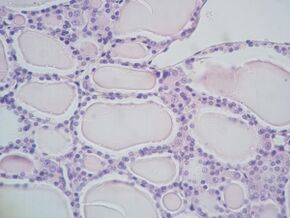Biology:Parafollicular cell
| Parafollicular cell | |
|---|---|
 Microscopic section of the thyroid showing follicles lined by follicular epithelial cells, and in between them larger parafollicular cells. | |
| Details | |
| Location | Thyroid |
| Function | Calcitonin secretion |
| Anatomical terms of microanatomy | |
Parafollicular cells, also called C cells, are neuroendocrine cells in the thyroid. The primary function of these cells is to secrete calcitonin. They are located adjacent to the thyroid follicles and reside in the connective tissue. These cells are large and have a pale stain compared with the follicular cells. In teleost and avian species these cells occupy a structure outside the thyroid gland named the ultimopharyngeal body.
Structure
Parafollicular cells are pale-staining cells found in small number in the thyroid and are typically situated basally in the epithelium, without direct contact with the follicular lumen. They are always situated within the basement membrane, which surrounds the entire follicle.
Development
Parafollicular cells are derived from pharyngeal endoderm.[1][2] Embryologically, they associate with the ultimopharyngeal body, which is a ventral derivative of the fourth (or fifth) pharyngeal pouch. Parafollicular cells were previously believed to be derived from the neural crest based on a series of experiments in quail-chick chimeras.[3][4] However, lineage tracing experiments in mice revealed that parafollicular cells are derived from the endoderm origin.[5]
Function
Parafollicular cells secrete calcitonin, a hormone that participates in the regulation of calcium metabolism. Calcitonin lowers blood levels of calcium by inhibiting the resorption of bone by osteoclasts, and its secretion is increased proportionally with the concentration of calcium.[6]
Parafollicular cells are also known to secrete in smaller quantities several neuroendocrine peptides such as serotonin, somatostatin or CGRP.[7][8][9] They may also have a role in regulating thyroid hormones production locally, as they express thyrotropin-releasing hormone.[10][11]
Clinical significance
When parafollicular cells become cancerous, they lead to medullary carcinoma of the thyroid.[citation needed]
See also
- List of human cell types derived from the germ layers
- List of distinct cell types in the adult human body
References
- ↑ "On the Origin of Cells and Derivation of Thyroid Cancer: C Cell Story Revisited". European Thyroid Journal 5 (2): 79–93. July 2016. doi:10.1159/000447333. PMID 27493881.
- ↑ Johansson, E., Andersson, L., Örnros, J., Carlsson, T., Ingeson-Carlsson, C., Liang, S., … Nilsson, M. (2015). Revising the embryonic origin of thyroid C cells in mice and humans. Development, 142(20), 3519–3528. http://doi.org/10.1242/dev.126581
- ↑ "New studies on the neural crest origin of the avian ultimobranchial glandular cells--interspecific combinations and cytochemical characterization of C cells based on the uptake of biogenic amine precursors". Histochemistry 38 (4): 297–305. March 1974. doi:10.1007/bf00496718. PMID 4135055.
- ↑ "Thyrotropin induces the acidification of the secretory granules of parafollicular cells by increasing the chloride conductance of the granular membrane". The Journal of Cell Biology 107 (6 Pt 1): 2137–47. December 1988. doi:10.1083/jcb.107.6.2137. PMID 2461947.
- ↑ "Revising the embryonic origin of thyroid C cells in mice and humans". Development 142 (20): 3519–28. October 2015. doi:10.1242/dev.126581. PMID 26395490.
- ↑ Williams Textbook of Endocrinology (12th ed.). Saunders. 2011. pp. 1250–1252. ISBN 978-1437703245.
- ↑ "Ultrastructural localization of calcitonin, somatostatin and serotonin in parafollicular cells of rat thyroid". The Histochemical Journal 16 (12): 1265–72. December 1984. doi:10.1007/bf01003725. PMID 6152264.
- ↑ "Induction of a neural phenotype in a serotonergic endocrine cell derived from the neural crest". The Journal of Neuroscience 7 (9): 2874–83. September 1987. doi:10.1523/JNEUROSCI.07-09-02874.1987. PMID 3305802.
- ↑ "Separation of dissociated thyroid follicular and parafollicular cells: association of serotonin binding protein with parafollicular cells". The Journal of Cell Biology 88 (3): 499–508. March 1981. doi:10.1083/jcb.88.3.499. PMID 7217200.
- ↑ "Thyrotropin-releasing hormone gene expression in normal thyroid parafollicular cells". Molecular Endocrinology 3 (12): 2101–9. December 1989. doi:10.1210/mend-3-12-2101. PMID 2516877.
- ↑ "Functional expression of the thyrotropin receptor in C cells: new insights into their involvement in the hypothalamic-pituitary-thyroid axis". Journal of Anatomy 215 (2): 150–8. August 2009. doi:10.1111/j.1469-7580.2009.01095.x. PMID 19493188.
Further reading
- "Localization of immunoreactive calcitonin gene-related peptide in thyroid C cells from various mammalian species". The Anatomical Record 219 (2): 204–12. October 1987. doi:10.1002/ar.1092190214. PMID 3120623.
- "Mash1 regulates the development of C cells in mouse thyroid glands". Developmental Dynamics 236 (1): 262–70. January 2007. doi:10.1002/dvdy.21018. PMID 17103415.
- "Expression of the epithelial marker E-cadherin by thyroid C cells and their precursors during murine development". The Journal of Histochemistry and Cytochemistry 55 (10): 1075–88. October 2007. doi:10.1369/jhc.7a7179.2007. PMID 17595340.
- "FRS2alpha is required for the separation, migration, and survival of pharyngeal-endoderm derived organs including thyroid, ultimobranchial body, parathyroid, and thymus". Developmental Dynamics 238 (3): 503–13. March 2009. doi:10.1002/dvdy.21867. PMID 19235715.
- "Cellular and molecular events on the development of mammalian thyroid C cells". Developmental Dynamics 245 (3): 323–41. March 2016. doi:10.1002/dvdy.24377. PMID 26661795.
- "Contributions to the Minute Anatomy of the Thyroid Gland of the Dog". Philosophical Transactions of the Royal Society of London 166: 557–568. 1876. doi:10.1098/rstl.1876.0021.
External links
- Histology image: 42_04 at the University of Oklahoma Health Sciences Center
- Histology image: 14302loa – Histology Learning System at Boston University
- Histology at KUMC endo-/endo10
- Anatomy Atlases - Microscopic Anatomy, plate 15.287
 |

